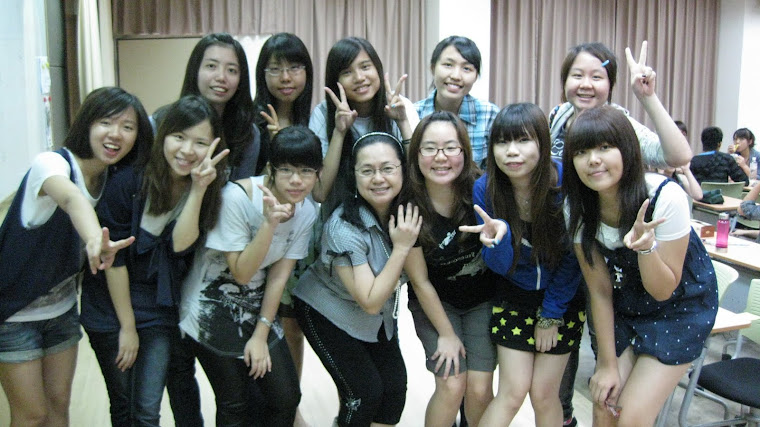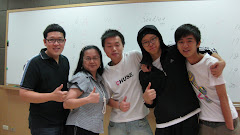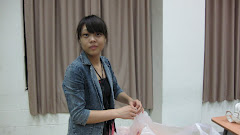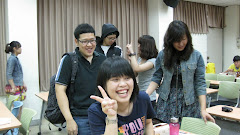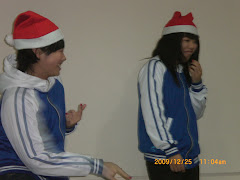Discussion Topic Five (2010/3/29~4/11):
Discussion Topics:
(1) What does it mean by "taming" ?
(2) Had the little girl tamed the fox eventually?
Based on The Little Prince, the story of "The Fox and I" portrays a story in which a ten-year old girl was trying hard to make friends with a fox in the wilderness.
The story tells us the secret of making friends as well as the difficult lesson of letting go this friend eventually.
Please consider the following points:
* What strategies did the little girl adopt to establish a relationship with the fox?
*How did the fox come to accept the girl as a friend? How did it overcome the fear of humans and then open her family to the girl?
*In the later part of their relationship, the little girl thought of putting a collar around the neck of the fox and even introducing her into the house and subsequently her sleeping chamber. By doing this, had the little girl made any mistakes in terms of friendship?
*After the little girl grew up to be a mother, what did she think of the fox's departure from her (after the fox's recovering from the wound)? Did she think that the fox has betryed their friendship? Had she learned to accept this separation?
*Whom was actually tamed in the end?
3/29/10
Beatrix Potter:Midterm project and group work
Midtern porject (3/29/2010~4/19):
A self-made story book based on Beatrix Potter's The Tale of Peter Rabbit
Group work of drama adaptation(3/29~4/12):
The presentation of a play based on Beatrix Potter's The Tale of Banjamin Bunny
A self-made story book based on Beatrix Potter's The Tale of Peter Rabbit
Group work of drama adaptation(3/29~4/12):
The presentation of a play based on Beatrix Potter's The Tale of Banjamin Bunny
3/22/10
Topic Four: Miss Potter and Peter Rabbit 彼得兔的誕生
Discussion Topic Four (2010/3/22~3/28):
The story in the film "Miss Potter" portrays important events in Beatrix Potter's life, including the loss of her first love, the beginning of her career as a painter for children's books, and her devotion to protect the beauty of Nature in the latter part of her life. Beatrix was depicted as a woman endowed with talents, integrity, and especially a young heart that loves animals and the natural world. It is from the young heart of this woman that Peter Rabbit has found its home.
Discussion questions:
(1) How do you find Beatrix Potter's life? Interesting and exciting? Creative and inspiring? Brave and revolutionary?
(2) Do you admire Beatrix Potter in any way? Her determination to become a painter? Her independence in terms of finance and character? Her innocent mind and young heart? Her love for animals and the natural world?
(3) What is your favorite passtime? Drawing? Knitting? Taking photographs? Writing? Do you think you can pursue a carrer in that field?
II. For more information about Beatrix Potter's life and her work, please visit the website of The World of Peter Rabbit:
http://www.peterrabbit.com/
The story in the film "Miss Potter" portrays important events in Beatrix Potter's life, including the loss of her first love, the beginning of her career as a painter for children's books, and her devotion to protect the beauty of Nature in the latter part of her life. Beatrix was depicted as a woman endowed with talents, integrity, and especially a young heart that loves animals and the natural world. It is from the young heart of this woman that Peter Rabbit has found its home.
Discussion questions:
(1) How do you find Beatrix Potter's life? Interesting and exciting? Creative and inspiring? Brave and revolutionary?
(2) Do you admire Beatrix Potter in any way? Her determination to become a painter? Her independence in terms of finance and character? Her innocent mind and young heart? Her love for animals and the natural world?
(3) What is your favorite passtime? Drawing? Knitting? Taking photographs? Writing? Do you think you can pursue a carrer in that field?
I. We will study the following two stories carefully, read them aloud in groups, and translate them from English to Chinese.
A. The Tale of Peter Rabbit
B. The Tale of Benjamin Bunny
II. For more information about Beatrix Potter's life and her work, please visit the website of The World of Peter Rabbit:
http://www.peterrabbit.com/
3/21/10
Website to view picture books
To view picture books written and made by our schoolmates, or related to famous paintings, please visit this website:
You need a password to view this blog.
If you forget it, just ask your instructor.
Topic Three: Presentation of Big Picture Books 大書呈現
Discussion Topic Three (2010/3/15~2010/3/21):
Discussion topic:
My experience of presenting a big book to the audience
在觀眾面前呈現英語圖畫大書,並錄製影片的經驗
My experience of presenting a big book to the audience
在觀眾面前呈現英語圖畫大書,並錄製影片的經驗
Group One:
"Flower Garden"
Group members:
金巧,依庭,曉喬,雅馨,盺展
Group Two:
"Birthday Gift"
Group Members:
鈞堯,佩君,曼寧,宜君,亭穎
Group Three:
"Mr. Gumpy's Outing"
Group members:
詩涵,依旻,奕莛,偉達
Group Four: "The
Very Hungry Catipillar"
Group Members:
加宜,方瑀,美智,子清
Group Five:
"Magic School Bus"
Group Members:
華玲,冠茹,昱翔,幼鳳,彥青,韋霖
Group Six:
"After the Storm"
Group Members:
雅倩,昱葳,怡如,雅涵,筱瑄
Group Seven:
"Farmer Duck"
Group Members:
世棋,培誼,敏容,郁琪,雅君,鈴揚
Some questions for you to think about:
(1)How did your group present the big picture book? Acting out? Reading together?
(2) Did the filming make you feel nervous?
(3) Did the audience respond to your presentation?
(4) How did your presentation go?
(5)In what way would you like to try to make your presentation next time even better than this one?
Labels:
Presentation in class
3/8/10
Topic Two: A Child's Perspective 小孩子的觀點
Discussion Topic Two (2010/3/8~3/14):
Text for discussions:
Persepolis 茉莉人生
The author of the four-volumed pucture books is an Iranian cartoonist named Marjane Satrapi, who was born in Rasht, Iran, in 1969. She later adapted her picture novels into a film script and directed the movie with Vincent Paronnaud.
She told her stories with keen observation and intriguing pictures from a pure and innocent mind vis-a-vis the political turmoils in Iran. Iran, formerly called Persia, was one of the great ancient civilizations, and "Persepolis" was originally the name for the empire's capital city. Therefore, in telling her own stories of growing up in Iran and in Europe, Satrapi also shows her pride in her own cultural heritage as well as her deep expectation for a bright future.
Her works were originally written in French. There is a focus for each of the four volumes:
Persepolis 1 (2000): I Grew up in Iran
Persepolis 2 (2001): I Grew up in Iran
Persepolis 3 (2002): Hide and Seek
Persepolis 4 (2003): The Day of Recess
Questions for discussions:
Satrapi described her childhood in Iran
and her teenage days in Europe from
a unique perspective. This vision is both
innocent and sophisticated, sincere and sad.
More importantly, Satrapi expressed her
views in vivid pictures portrayed in Iranian
style and with a much appreciated sense
of humor that turns pains and sorrows into
interesting stories.
1. What do you think are the marked
traits of Satrapi's perspective? How is
this standpoint different from yours
and from the people around you?
2. How did Satrapi, as a child and
as a teenager,perveive the world she
lived in, first Iran and then Europe?
3. How do you perceive the world
you live in? What kind of state
of mind do you presently have?
4. Do you think a "young child's perspective"
would help you in some ways?
Text for discussions:
Persepolis 茉莉人生
The author of the four-volumed pucture books is an Iranian cartoonist named Marjane Satrapi, who was born in Rasht, Iran, in 1969. She later adapted her picture novels into a film script and directed the movie with Vincent Paronnaud.
She told her stories with keen observation and intriguing pictures from a pure and innocent mind vis-a-vis the political turmoils in Iran. Iran, formerly called Persia, was one of the great ancient civilizations, and "Persepolis" was originally the name for the empire's capital city. Therefore, in telling her own stories of growing up in Iran and in Europe, Satrapi also shows her pride in her own cultural heritage as well as her deep expectation for a bright future.
Her works were originally written in French. There is a focus for each of the four volumes:
Persepolis 1 (2000): I Grew up in Iran
Persepolis 2 (2001): I Grew up in Iran
Persepolis 3 (2002): Hide and Seek
Persepolis 4 (2003): The Day of Recess
Questions for discussions:
Satrapi described her childhood in Iran
and her teenage days in Europe from
a unique perspective. This vision is both
innocent and sophisticated, sincere and sad.
More importantly, Satrapi expressed her
views in vivid pictures portrayed in Iranian
style and with a much appreciated sense
of humor that turns pains and sorrows into
interesting stories.
1. What do you think are the marked
traits of Satrapi's perspective? How is
this standpoint different from yours
and from the people around you?
2. How did Satrapi, as a child and
as a teenager,perveive the world she
lived in, first Iran and then Europe?
3. How do you perceive the world
you live in? What kind of state
of mind do you presently have?
4. Do you think a "young child's perspective"
would help you in some ways?
3/2/10
Topic One: Forever Young 永遠的十七歲
Discussion Topic One (2010/3/1~3/7):
1.What does it mean to be young?
2.Why do people want to be forever young?
3.Why do people particularly want to be seventeen again?
4. If you were given the chance to go back in time, would you take the chance? Why?
5. Would you try to mend the mistakes you had made before? Would you grab the opportunity to make some change in the past for the sake of a better future?
6. Do you think the "going back to the past" endeavors would actually change anything?
7. It is said that many people are making great efforts, attempting to change the world (or other people), but not many people are thinking of changing themselves.
What do you think of this statement?
1.What does it mean to be young?
2.Why do people want to be forever young?
3.Why do people particularly want to be seventeen again?
4. If you were given the chance to go back in time, would you take the chance? Why?
5. Would you try to mend the mistakes you had made before? Would you grab the opportunity to make some change in the past for the sake of a better future?
6. Do you think the "going back to the past" endeavors would actually change anything?
7. It is said that many people are making great efforts, attempting to change the world (or other people), but not many people are thinking of changing themselves.
What do you think of this statement?
Reflections on the story of "17 Again"
Let's take the protagonist, Mike, as an example, to think over the questions listed above.
3/1/10
Teaching English to Children 兒童英語教學課程
2010.2.
兒童英語教學課程目標:
本課程針對幼稚園與國小學童的英語師資而設計,
考量本階段兒童身心發展的程度,
在教材與教法的搭配上提供學理的引介與實務上的訓練。
I. Required Text:
Teaching Children English. by David Vale and Anne Feunteun. Cambridge: Cambridge UP, 2003.
II. Important Texts:
1. Culture in Second Language Teaching and Learning. Ed. by Eli Hinkel. Cambridge: Cambridge UP, 1999.
2. Pictures for Language Learning, by Andrew Wright. Cambridge: Cambridge UP,2003.
III. Teaching materials for practicum:
1. Content Area Reading (Levels A-F), by Teacher Created Materials, Inc. Taipei: Norton and Bookman, 2004.
2. Engligh 300 for Children, by Edwin T. Cornelius, Jr. Taipei: Studio Classroom, 2005.
IV. Syllabus:
Unit One: Approaches in Teaching Children English
Week 1 Introduction
Week 2 Attitudes and approaches
Week 3 An overview of three teaching approaches
Week 4 Building up a teaching sequence
Unit Two: Activities in Teaching Children English
Week 5 An overview of teaching techniques; teaching practice
Week 6 A focus on balancing various activities; teaching practice
Week 7 Storytelling, comprehension, errors, and correction; teaching practice
Week 8 Classroom management and organization; teaching practice
Unit Three: Key study areas in Teaching Children English
Week 9 Visual, musical, and other teaching aid; teaching practice
Week 10 Content and curriculum design; teaching practice
Week 11 Observation, assessment and records; teaching practice
Week 12 Communication with students, parents, and supervisors; teaching practice
Unit Four: Culture in Second Language Teaching and Learning
Week 13 Culture, context, and writing; teaching practice
Week 14 Developing skills in listening and interpreting cultural implication in conversation; teaching practice
Unit Five: Pictures for Language Learning
Week 15 Pictures for speaking and writing; teaching practice
Week 16 Pictures for listening and reading; teaching practice
Unit Six: Wrapping up
Week 17 Final (written) exam on the knowledge of teaching approaches
Week 18 Teaching practicum (final exam)
V. Percentile of final grades
1. In class participation, discussions and teaching practice: 30%
2. Exam on teaching principles, theory, and approaches: 30%
3. Teaching practicum: total 40%
(1) creation and preparation of teaching materials: 20%
(2) teaching approaches and classroom management: 20%
VI. Reference
1.Teaching Children English. by David Vale and Anne Feunteun. Cambridge: Cambridge UP, 2003.
2.Culture in Second Language Teaching and Learning. Ed. by Eli Hinkel. Cambridge: Cambridge UP, 1999.
3.Pictures for Language Learning, by Andrew Wright. Cambridge: Cambridge UP,2003.
4.Content Area Reading (Levels A-F), by Teacher Created Materials, Inc. Taipei: Norton and Bookman, 2004.
5.Engligh 300 for Children, by Edwin T. Cornelius, Jr. Taipei: Studio Classroom, 2005.
兒童英語教學課程目標:
本課程針對幼稚園與國小學童的英語師資而設計,
考量本階段兒童身心發展的程度,
在教材與教法的搭配上提供學理的引介與實務上的訓練。
I. Required Text:
Teaching Children English. by David Vale and Anne Feunteun. Cambridge: Cambridge UP, 2003.
II. Important Texts:
1. Culture in Second Language Teaching and Learning. Ed. by Eli Hinkel. Cambridge: Cambridge UP, 1999.
2. Pictures for Language Learning, by Andrew Wright. Cambridge: Cambridge UP,2003.
III. Teaching materials for practicum:
1. Content Area Reading (Levels A-F), by Teacher Created Materials, Inc. Taipei: Norton and Bookman, 2004.
2. Engligh 300 for Children, by Edwin T. Cornelius, Jr. Taipei: Studio Classroom, 2005.
IV. Syllabus:
Unit One: Approaches in Teaching Children English
Week 1 Introduction
Week 2 Attitudes and approaches
Week 3 An overview of three teaching approaches
Week 4 Building up a teaching sequence
Unit Two: Activities in Teaching Children English
Week 5 An overview of teaching techniques; teaching practice
Week 6 A focus on balancing various activities; teaching practice
Week 7 Storytelling, comprehension, errors, and correction; teaching practice
Week 8 Classroom management and organization; teaching practice
Unit Three: Key study areas in Teaching Children English
Week 9 Visual, musical, and other teaching aid; teaching practice
Week 10 Content and curriculum design; teaching practice
Week 11 Observation, assessment and records; teaching practice
Week 12 Communication with students, parents, and supervisors; teaching practice
Unit Four: Culture in Second Language Teaching and Learning
Week 13 Culture, context, and writing; teaching practice
Week 14 Developing skills in listening and interpreting cultural implication in conversation; teaching practice
Unit Five: Pictures for Language Learning
Week 15 Pictures for speaking and writing; teaching practice
Week 16 Pictures for listening and reading; teaching practice
Unit Six: Wrapping up
Week 17 Final (written) exam on the knowledge of teaching approaches
Week 18 Teaching practicum (final exam)
V. Percentile of final grades
1. In class participation, discussions and teaching practice: 30%
2. Exam on teaching principles, theory, and approaches: 30%
3. Teaching practicum: total 40%
(1) creation and preparation of teaching materials: 20%
(2) teaching approaches and classroom management: 20%
VI. Reference
1.Teaching Children English. by David Vale and Anne Feunteun. Cambridge: Cambridge UP, 2003.
2.Culture in Second Language Teaching and Learning. Ed. by Eli Hinkel. Cambridge: Cambridge UP, 1999.
3.Pictures for Language Learning, by Andrew Wright. Cambridge: Cambridge UP,2003.
4.Content Area Reading (Levels A-F), by Teacher Created Materials, Inc. Taipei: Norton and Bookman, 2004.
5.Engligh 300 for Children, by Edwin T. Cornelius, Jr. Taipei: Studio Classroom, 2005.
Literature for Young Minds, syllabus 兒童文學課程
Course: Literature for Children and Teenagers
兒童與青少年文學 (2010.2.)
Instructor: Vinia
Schedule: Monday 1:10~4:00pm. General Education Building 715
Office hours:
Monday: 10:00am~12:00 noon; 4:00~5:00 pm
Tuesday 9:00~10:00am; 2:00~3:00 pm
Friday: 9:00~10:00 pm
Website:
http://intro-western-literature.blogspot.com
Literature for Young Minds
I. Objectives
本課程的主旨在訓練學生閱讀分析與思辨的能力,圖像解讀的能力與創意寫作之習慣,從三方面進行。
(1)針對兒童文學與青少年文學的,給予學生閱讀與分析上的訓練,並培養學生對不同文學主題和寫作風格的鑑賞能力。
(2)晚近又有奇幻文學經典改編成電影之熱潮,本課程藉由原著與改編之對照來強化學生的分析思辨能力。
(3)鼓勵學生發揮創意,嘗試中英雙語的繪本創作。並嘗試把經典作品改編成劇本,以供演出。
II. Syllabus
Week 1 (1) Introduction (2) The heroes in ”Transformers” (3) "Being young" in "17 Again"
Focus One: The Classical World
week 2 (1) Beowulf (2) King Arthur's legend
Week 3 (1) Anderson's Fairy Tales (2) Grimm's Fairy Tales
Focus Two: Fables and Picture Books
Week 4 (1) Peter Rabbits (2) Stuart Little
Week 5 (1) Charlotte's Web (2) The Little Prince
Focus Three: Novels and Motion Pictures
Week 6: Eragon 龍騎士
Week 7: Howl's Moving Castle
Week 8: The Kite Runner
Focus Four: The Theme of Adventures
Week 9: Charlie's Chocolate Factory
Week 10: The Adventures pf Baudelaire
Week 11: The Spiderwick Chronicles
Focus Five: The canon of Fantacy Literature
Week 12: The Hobbits and the Lord of the Rings
Week 13: Narnia
Week 14: Harry Potter
Focus Six: The Emerging New Works
Week 15: Inkheart 墨水心(by Cornelia Funke)
Week 16: Northern Lights: The Golden Compass 黃金羅盤 (by Philip Pullman)
Week 17: Twilight I~IV 暮光之城
Week 18: Final Exam
III. Percentile of final grades
1. Weekly exam on designated reading (25%)
2. Creation of a story with pictures (25%)
3. Choice of an English novel and
a. writing a 5-page report in English analyzing the novel, or
b. adapting the novel into a play about 30-page long.
c. performing a play or story-telling (25%)
4. Class attendance and participation in classroom discussion (25%)
IV. Reference
(1)The 20th-Century Childen's Book Treasury. By Janet Schulman. New York: Alfred A. Knopf., 1998.
(2)The 20th-Century Childen's Poetry Treasury. Selected by Jack Prelutsky. Illustrated by Meilo SO. New York: Alfred A. Knopf., 1999.
(3)Beatrix Potter: The Complete Tales. Authorized Edition by Frederick Warne. London: Penguin, 2002.
兒童與青少年文學 (2010.2.)
Instructor: Vinia
Schedule: Monday 1:10~4:00pm. General Education Building 715
Office hours:
Monday: 10:00am~12:00 noon; 4:00~5:00 pm
Tuesday 9:00~10:00am; 2:00~3:00 pm
Friday: 9:00~10:00 pm
Website:
http://intro-western-literature.blogspot.com
Literature for Young Minds
I. Objectives
本課程的主旨在訓練學生閱讀分析與思辨的能力,圖像解讀的能力與創意寫作之習慣,從三方面進行。
(1)針對兒童文學與青少年文學的,給予學生閱讀與分析上的訓練,並培養學生對不同文學主題和寫作風格的鑑賞能力。
(2)晚近又有奇幻文學經典改編成電影之熱潮,本課程藉由原著與改編之對照來強化學生的分析思辨能力。
(3)鼓勵學生發揮創意,嘗試中英雙語的繪本創作。並嘗試把經典作品改編成劇本,以供演出。
II. Syllabus
Week 1 (1) Introduction (2) The heroes in ”Transformers” (3) "Being young" in "17 Again"
Focus One: The Classical World
week 2 (1) Beowulf (2) King Arthur's legend
Week 3 (1) Anderson's Fairy Tales (2) Grimm's Fairy Tales
Focus Two: Fables and Picture Books
Week 4 (1) Peter Rabbits (2) Stuart Little
Week 5 (1) Charlotte's Web (2) The Little Prince
Focus Three: Novels and Motion Pictures
Week 6: Eragon 龍騎士
Week 7: Howl's Moving Castle
Week 8: The Kite Runner
Focus Four: The Theme of Adventures
Week 9: Charlie's Chocolate Factory
Week 10: The Adventures pf Baudelaire
Week 11: The Spiderwick Chronicles
Focus Five: The canon of Fantacy Literature
Week 12: The Hobbits and the Lord of the Rings
Week 13: Narnia
Week 14: Harry Potter
Focus Six: The Emerging New Works
Week 15: Inkheart 墨水心(by Cornelia Funke)
Week 16: Northern Lights: The Golden Compass 黃金羅盤 (by Philip Pullman)
Week 17: Twilight I~IV 暮光之城
Week 18: Final Exam
III. Percentile of final grades
1. Weekly exam on designated reading (25%)
2. Creation of a story with pictures (25%)
3. Choice of an English novel and
a. writing a 5-page report in English analyzing the novel, or
b. adapting the novel into a play about 30-page long.
c. performing a play or story-telling (25%)
4. Class attendance and participation in classroom discussion (25%)
IV. Reference
(1)The 20th-Century Childen's Book Treasury. By Janet Schulman. New York: Alfred A. Knopf., 1998.
(2)The 20th-Century Childen's Poetry Treasury. Selected by Jack Prelutsky. Illustrated by Meilo SO. New York: Alfred A. Knopf., 1999.
(3)Beatrix Potter: The Complete Tales. Authorized Edition by Frederick Warne. London: Penguin, 2002.
Subscribe to:
Comments (Atom)

